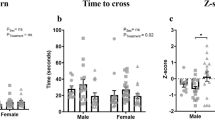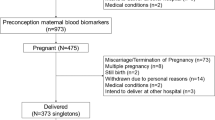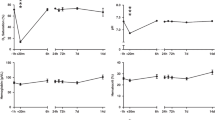Abstract
BACKGROUND
White matter brain injury in preterm infants can induce neurodevelopmental deficits. Umbilical cord blood (UCB) cells demonstrate neuroprotective properties, but it is unknown whether cells obtained from preterm cord blood (PCB) vs. term cord blood (TCB) have similar efficacy. This study compared the ability of TCB vs. PCB cells to reduce white matter injury in preterm fetal sheep.
METHODS
Hypoxia–ischemia (HI) was induced in fetal sheep (0.7 gestation) by 25 min umbilical cord occlusion. Allogeneic UCB cells from term or preterm sheep, or saline, were administered to the fetus at 12 h after HI. The fetal brain was collected at 10-day post HI for assessment of white matter neuropathology.
RESULTS
HI (n=7) induced cell death and microglial activation and reduced total oligodendrocytes and CNPase+myelin protein in the periventricular white matter and internal capsule when compared with control (n=10). Administration of TCB or PCB cells normalized white matter density and reduced cell death and microgliosis (P<0.05). PCB prevented upregulation of plasma tumor necrosis factor (TNF)-a, whereas TCB increased anti-inflammatory interleukin (IL)-10 (P<0.05). TCB, but not PCB, reduced circulating oxidative stress.
CONCLUSIONS
TCB and PCB cells reduced preterm HI-induced white matter injury, primarily via anti-inflammatory actions. The secondary mechanisms of neuroprotection appear different following TCB vs. PCB administration.
Similar content being viewed by others
Log in or create a free account to read this content
Gain free access to this article, as well as selected content from this journal and more on nature.com
or
References
Volpe JJ . Cerebral white matter injury of the premature infant: more common than you think. Pediatrics 2003;112:176–80.
Pimentel-Coelho PM, Magalhães ES, Lopes LM et al, Human cord blood transplantation in a neonatal rat model of hypoxic-ischemic brain damage: Functional outcome related to neuroprotection in the striatum. Stem Cells Dev 2010;19:351–8.
Meier C, Middelanis J, Wasielewski B et al, Spastic paresis after perinatal brain damage in rats is reduced by human cord blood mononuclear cells. Pediatr Res 2006;59:244–9.
Geissler M . Human umbilical cord blood cells restore brain damage induced changes in rat somatosensory cortex. PLoS ONE 2011;6:e20194.
Wasielewski B, Jensen A, Roth-Härer A, Dermietzel R, Meier C . Neuroglial activation and Cx43 expression are reduced upon transplantation of human umbilical cord blood cells after perinatal hypoxic-ischemic injury. Brain Res 2012;1487:39–53.
Li J, McDonald C, Fahey MC, Jenkin G, Miller SL . Could cord blood cell therapy reduce preterm brain injury? Front Neurol 2014;5:200.
Drobyshevsky A, Cotten CM, Shi Z et al, Human umbilical cord blood cells ameliorate motor deficits in rabbits in a cerebral palsy model. Dev Neurosci 2015;37:349–62.
Hall AA, Guyer AG, Leonardo CC et al, Human umbilical cord blood cells directly suppress ischemic oligodendrocyte cell death. J Neurosci Res 2009;87:333–41.
Li J, Yawno T, Sutherland A et al, Preterm white matter brain injury is prevented by early administration of umbilical cord blood cells. Exp Neurol 2016;283:179–87.
Aridas JDS, McDonald CA, Paton MCB et al, Cord blood mononuclear cells prevent neuronal apoptosis in response to perinatal asphyxia in the newborn lamb. J Physiol 2016;594:1421–35.
Trønnes H, Wilcox AJ, Lie RT, Markestad T, Moster D . Risk of cerebral palsy in relation to pregnancy disorders and preterm birth: a national cohort study. Dev Med Child Neurol 2014;56:779–85.
Novak I, Walker K, Hunt R, Wallace E, Fahey M, Badawi N . Concise review: stem cell interventions for people with cerebral palsy: systematic review with meta-analysis. Stem Cells Transl Med 2016;5:1014–25.
Boltze J, Schmidt UR, Reich DM et al, Determination of the therapeutic time window for human umbilical cord blood mononuclear cell transplantation following experimental stroke in rats. Cell Transplant 2012;21:1199–211.
Solves P, López M, Mirabet V, Blanquer A, Roig R, Perales A . Characteristics of umbilical cord blood units collected from preterm deliveries. Gynecol Obstetr Invest 2009;68:181–5.
Javed MJ, Mead LE, Prater D et al, Endothelial colony forming cells and mesenchymal stem cells are enriched at different gestational ages in human umbilical cord blood. Pediatr Res 2008;64:68–73.
Jain A, Mathur N, Jeevashankar M et al, Does mesenchymal stem cell population in umbilical cord blood vary at different gestational periods? Indian J Pediatr 2013;80:375–9.
Cervera A, Lillo R, García-Sánchez F, Madero L, Madero R, Vicario JL . Flow cytometric assessment of hematopoietic cell subsets in cryopreserved preterm and term cord blood, influence of obstetrical parameters, and availability for transplantation. Am J Hematol 2006;81:397–410.
Gasparoni A, Ciardelli L, Avanzini MA et al, Immunophenotypic changes of fetal cord blood hematopoietic progenitor cells during gestation. Pediatr Res 2000;47:825–9.
Surbek DV, Holzgreve W, Jansen W et al, Quantitative immunophenotypic characterization, cryopreservation, and enrichment of second-and third-trimester human fetal cord blood hematopoietic stem cells (progenitor cells). Am J Obstetr Gynecol 1998;179:1228–33.
Czeh M, Gressens P, Kaindl AM . The yin and yang of microglia. Dev Neurosci 2011;33:199–209.
Hagberg H, Mallard C, Ferriero DM et al, The role of inflammation in perinatal brain injury. Nat Rev Neurol 2015;11:192–208.
Buser JR, Maire J, Riddle A et al, Arrested preoligodendrocyte maturation contributes to myelination failure in premature infants. Ann Neurol 2012;71:93–109.
Arien-Zakay H, Lecht S, Bercu MM et al, Neuroprotection by cord blood neural progenitors involves antioxidants, neurotrophic and angiogenic factors. Exp Neurol 2009;216:83–94.
Valle-Prieto A, Conget PA . Human mesenchymal stem cells efficiently manage oxidative stress. Stem Cells Dev 2010;19:1885–93.
Ito K, Hirao A, Arai F et al, Regulation of oxidative stress by ATM is required for self-renewal of haematopoietic stem cells. Nature 2004;431:997–1002.
Said EA, Dupuy FP, Trautmann L et al, Programmed death-1–induced interleukin-10 production by monocytes impairs CD4(+) T cell activation during HIV infection. Nat Med 2010;16:452–9.
Christensen RD, Del Vecchio A, Henry E . Expected erythrocyte, platelet and neutrophil values for term and preterm neonates. J Maternal Fetal Neonatal Med 2012;25:77–9.
Prockop DJ, Youn Oh J . Mesenchymal stem/stromal cells (MSCs): role as guardians of inflammation. Mol Ther 2012;20:14–20.
Kang M, Min K, Jang J et al, Involvement of immune responses in the efficacy of cord blood cell therapy for cerebral palsy. Stem Cells Dev 2015;24:2259–68.
Yu G, Borlongan CV, Stahl CE et al, Systemic delivery of umbilical cord blood cells for stroke therapy: a review. Restorative Neurol Neurosci 2009;27:41–54.
Surbek DV, Glanzmann R, Senn HP, Hoesli I, Holzgreve W . Can cord blood be used for autologous transfusion in preterm neonates? Eur J Pediatrics 2000;159:790–1.
Hosono S, Hine K, Nagano N et al, Residual blood volume in the umbilical cord of extremely premature infants. Pediatr Int 2015;57:68–71.
Kotiranta-Ainamo A, Apajasalo M, Pohjavuori M, Rautonen N, Rautonen J . Mononuclear cell subpopulations in preterm and full-term neonates: independent effects of gestational age, neonatal infection, maternal pre- eclampsia, maternal betamethason therapy, and mode of delivery. Clin Exp Immunol 1999;115:309–14.
Jones J, Stevens CE, Rubinstein P, Robertazzi RR, Kerr A, Cabbad MF . Obstetric predictors of placental/umbilical cord blood volume for transplantation. Am J Obstetr Gynecol 2003;188:503–9.
Larrivée B, Niessen K, Pollet I et al, Minimal contribution of marrow-derived endothelial precursors to tumor vasculature. J Immunol 2005;175:2890–9.
Lee OK, Kuo TK, Chen WM, Lee KD, Hsieh SL, Chen TH . Isolation of multipotent mesenchymal stem cells from umbilical cord blood. Blood 2004;103:1669–75.
Tsuji M, Taguchi A, Ohshima M et al, Effects of intravenous administration of umbilical cord blood CD34+ cells in a mouse model of neonatal stroke. Neuroscience 2014;263:148–58.
Xia G, Hong X, Chen X, Lan F, Zhang G, Liao L . Intracerebral transplantation of mesenchymal stem cells derived from human umbilical cord blood alleviates hypoxic ischemic brain injury in rat neonates. J Perinatal Med 2010;38:215–21.
Shahaduzzaman M, Golden JE, Green S et al, A single administration of human umbilical cord blood T cells produces long-lasting effects in the aging hippocampus. Age 2013;35:2071–87.
Womble TA, Green S, Shahaduzzaman M et al, Monocytes are essential for the neuroprotective effect of human cord blood cells following middle cerebral artery occlusion in rat. Mol Cell Neurosci 2014;59:76–84.
Alves de Alencar Rocha AK, Allison BJ, Yawno T et al, Early- versus late-onset fetal growth restriction differentially affects the development of the fetal sheep brain. Dev Neurosci 2017;39:141–155.
Trapp BD, Bernier L, Andrews SB, Colman DR . Cellular and subcellular distribution of 2',3'-cyclic nucleotide 3'-phosphodiesterase and its mRNA in the rat central nervous system. J Neurochem 1988;51:859–68.
Author information
Authors and Affiliations
Corresponding author
Ethics declarations
Competing interests
The authors declare no conflict of interest.
Additional information
Statement of Financial Support
This work was made possible with financial support from Inner Wheel Australia, L.E.W. Carty Charitable Fund, Victorian Government Operational Infrastructure Support Program, an NHMRC Australia Project Grant (APP1081516) and ARC Future Fellowship to SLM.
Rights and permissions
About this article
Cite this article
Li, J., Yawno, T., Sutherland, A. et al. Term vs. preterm cord blood cells for the prevention of preterm brain injury. Pediatr Res 82, 1030–1038 (2017). https://doi.org/10.1038/pr.2017.170
Received:
Accepted:
Published:
Issue date:
DOI: https://doi.org/10.1038/pr.2017.170
This article is cited by
-
Updates on neonatal cell and novel therapeutics: Proceedings of the Second Neonatal Cell Therapies Symposium (2024)
Pediatric Research (2025)
-
Effects of fetal growth restriction on the perinatal neurovascular unit and possible treatment targets
Pediatric Research (2024)
-
Comparison of Biological Characteristics of Human Umbilical Cord Wharton’s Jelly-Derived Mesenchymal Stem Cells from Extremely Preterm and Term Infants
Tissue Engineering and Regenerative Medicine (2023)
-
Assessing the impact of gestational age of donors on the efficacy of amniotic epithelial cell-derived extracellular vesicles in experimental bronchopulmonary dysplasia
Stem Cell Research & Therapy (2022)
-
First case of low-dose umbilical cord blood therapy for pediatric acute respiratory distress syndrome induced by Pneumocystis carinii pneumonia
European Journal of Medical Research (2021)



